Diurnal Variation Characteristics of Clouds and Precipitation during the Summer Season in Two Typical Climate Regions of the Tibetan Plateau
Abstract
:1. Introduction
2. Instruments and Methodology
2.1. Ka-Band Cloud Radar
2.2. PARSIVEL Disdrometer
3. Diurnal Variation of Cloud Vertical Structures (CVSs)
3.1. Occurrence Frequency (OF)
3.2. CBH, CTH and Cloud Layer Thickness
3.3. Radar Echoes
4. Diurnal Variation of Precipitation
4.1. Rain Rate and Occurrence Frequency
4.2. DSD Characteristics
5. Discussions
6. Conclusions
- (1)
- Cloud cover and precipitating clouds in Mêdog tend to form in the evening (e.g., 18:00–22:00 LST), occur frequently in the nighttime (e.g., 23:00–05:00 LST) and gradually dissipate in the daytime (e.g., 06:00–17:00 LST). The occurrence frequency of cloud cover in Nagqu increases around noon (e.g., 11:00–14:00 LST) and maintains a relatively higher occurrence frequency value from 14:00 to 21:00 LST, then gradually decreases during night and morning (e.g., 22:00–10:00 LST);
- (2)
- CTHs of non-precipitating clouds in Mêdog occur frequently at around 5 km AGL, whereas CTHs in Nagqu show two peaks, with one at 3–4 km AGL that is almost unchanged with time, and the other at 8–11 km AGL, which occurs more frequently at 15:00–02:00 LST. In terms of precipitating clouds, the CTHs in Mêdog mainly appear above 5 km AGL, and are much lower in the daytime (e.g., 09:00–20:00 LST) than in the nighttime (e.g., 21:00–08:00 LST). The CTH distribution in Nagqu exhibits the greatest height, above 10 km AGL, in late afternoon. The cloud layer thickness of non-precipitating clouds in Mêdog shows a bimodal structure, with one peak in late afternoon (e.g., 16:00 LST) and the other in the evening (e.g., 21:00 LST), while the cloud layer thickness of non-precipitating clouds in Nagqu shows a unimodal feature with a diurnal peak at 17:00 LST. The average profiles of radar reflectivity factors above the melting layer level (about 4 km AGL) in Mêdog show that the largest value appears during 18:00–24:00 LST and the smallest one occurs during 00:00–12:00 LST. In Nagqu, the average radar reflectivity during 12:00–18:00 (00:00–12:00) LST is the strongest (weakest);
- (3)
- The rain rate in Mêdog (Nagqu) peaks at 00:00 LST and 18:00 (12:00) LST. In Mêdog, the relative contribution of heavy rainfall (R > 10 mm h−1) to the cumulative rainfall is more significant at night (e.g., 18:00, 22:00, 00:00 LST), while in Nagqu, the heavy rainfall makes the largest contribution to the afternoon rainfall. For different precipitation types (cf. stratiform precipitation and convective precipitation), the stratiform precipitation is predominant in the two regions, and the diurnal variation in stratiform precipitation shows a similar pattern to that of total precipitation. The convective precipitation in Mêdog and Nagqu mainly occurs at 22:00–02:00 LST and 12:00–22:00 LST, respectively;
- (4)
- The diurnal variation in DSD of stratiform precipitation is not obvious in the two regions. As far as convective precipitation is concerned, the precipitation in Mêdog is generally characterized by a high concentration of limited-size raindrops and close to maritime-like population. The number concentration of large drops in Mêdog is the highest during 18:00–24:00 LST, with the largest Dm and the lowest Nw. The convective precipitation in Mêdog at 06:00–18:00 LST has less large raindrops with relatively lower Dm. In Nagqu, the convective precipitation during 12:00–18:00 (00:00–06:00) LST has the highest (lowest) concentration of large drops, and can be classified as a continental-like (maritime-like) population with the largest (smallest) Dm and the lowest (highest) Nw;
- (5)
- The relevant mechanisms for the discrepancies in diurnal variations between the two regions are also discussed in this paper. The low-level convergence of water vapor from evening to early morning in Mêdog and Nagqu results in the nocturnal peak of occurrence frequency of clouds and precipitation at the two sites. Stronger convergence in Mêdog than in Nagqu might lead to much higher occurrence frequency of clouds and precipitation in Mêdog. In addition, Mêdog is characterized by a significant diurnal cycle of mountain–valley wind. The interaction between the nocturnal down-valley winds and the background monsoon flow is the possible mechanism for the accumulation of water vapor and the development of convection in Mêdog. In Nagqu, the occurrence frequency and contribution of convective rain peaking in the afternoon are probably related to the isolated short-term thermal convection bubbles resulting from the surface sensible heat flux, which are difficult to capture using hourly ERA5 reanalysis data with coarse space resolution.
Author Contributions
Funding
Data Availability Statement
Acknowledgments
Conflicts of Interest
Appendix A
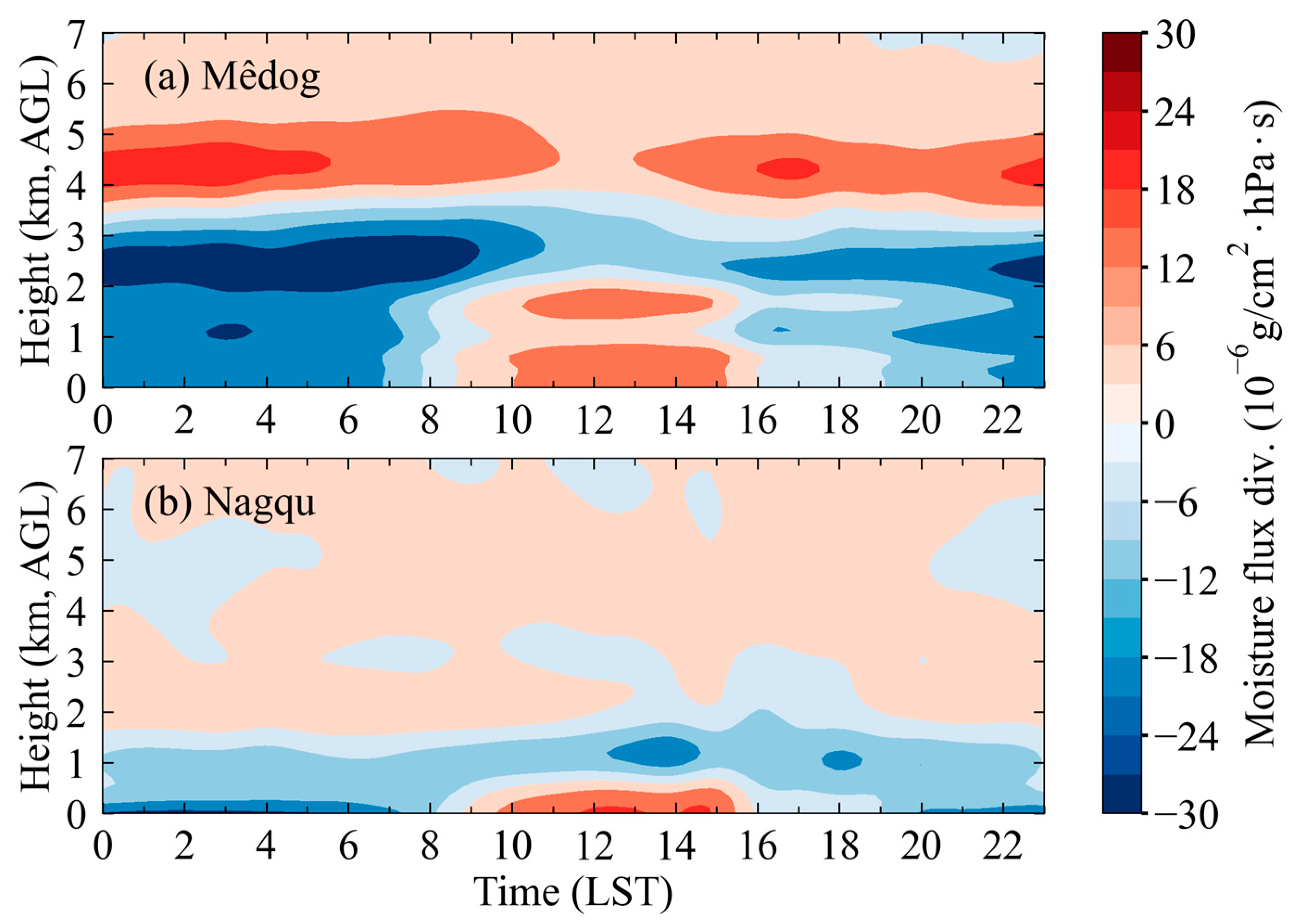
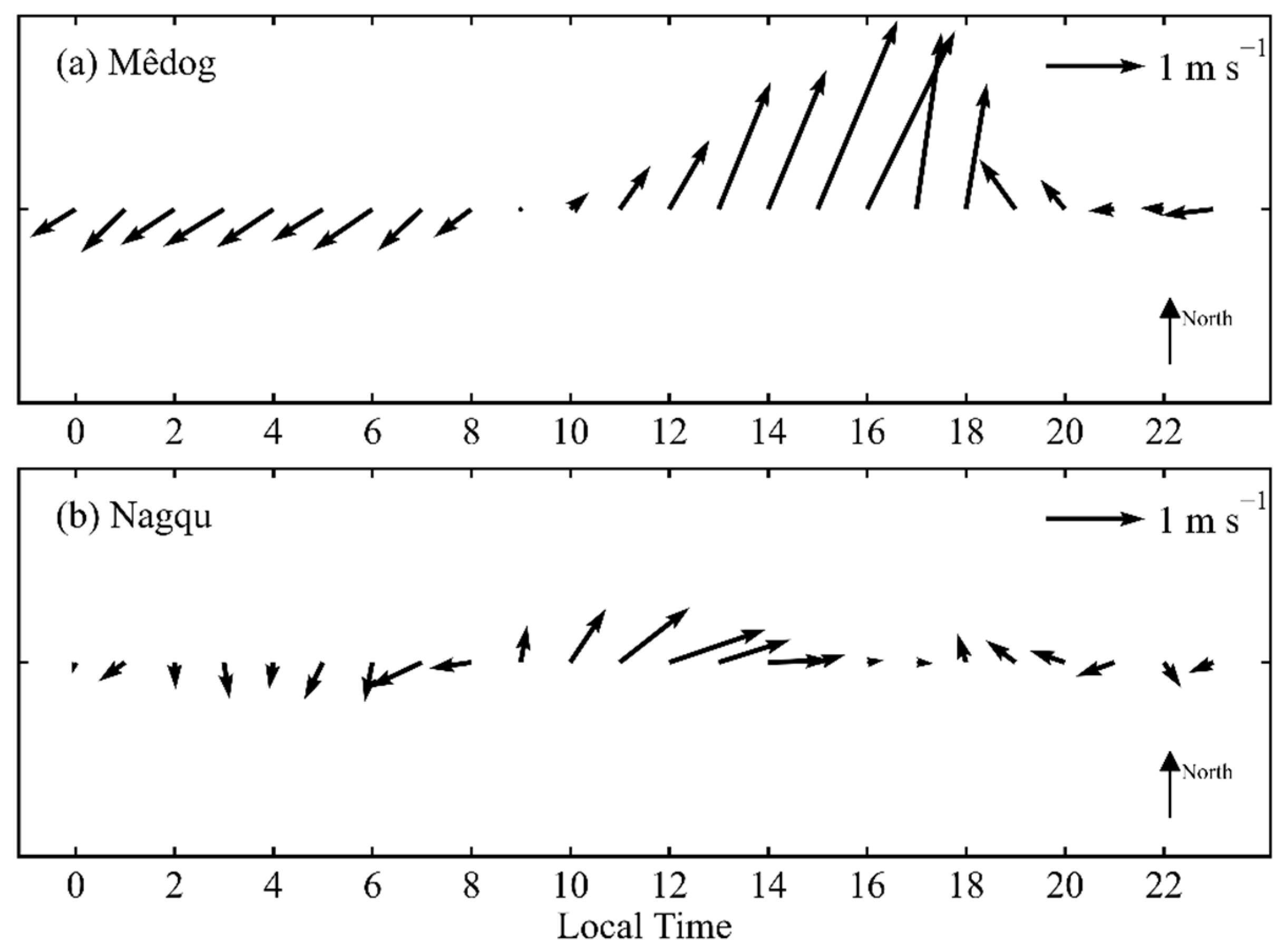

References
- Xu, X.; Lu, C.; Shi, X.; Gao, S. World Water Tower: An Atmospheric Perspective. Geophys. Res. Lett. 2008, 35, L20815. [Google Scholar] [CrossRef]
- Kang, S.C.; Xu, Y.W.; You, Q.L.; Flugel, W.A.; Pepin, N.; Yao, T.D. Review of Climate and Cryospheric Change in the Tibetan Plateau. Environ. Res. Lett. 2010, 5, 015101. [Google Scholar] [CrossRef]
- Hawkinson, J.A.; Feltz, W.; Ackerman, S.A. A Comparison of Goes Sounder- and Cloud Lidar- and Radar-Retrieved Cloud-Top Heights. J. Appl. Meteorol. 2005, 44, 1234–1242. [Google Scholar] [CrossRef]
- Fujinami, H.; Yasunari, T. The Seasonal and Intraseasonal Variability of Diurnal Cloud Activity over the Tibetan Plateau. J. Meteorol. Soc. Jpn. 2001, 79, 1207–1227. [Google Scholar] [CrossRef] [Green Version]
- Bhatt, B.C.; Nakamura, K. Characteristics of Monsoon Rainfall around the Himalayas Revealed by Trmm Precipitation Radar. Mon. Weather Rev. 2005, 133, 149–165. [Google Scholar] [CrossRef]
- Taniguchi, K.; Koike, T. Seasonal Variation of Cloud Activity and Atmospheric Profiles over the Eastern Part of the Tibetan Plateau. J. Geophys. Res. Atmos. 2008, 113, D10104. [Google Scholar] [CrossRef]
- Ramadhan, R.; Marzuki; Vonnisa, M.; Harmadi; Hashiguchi, H.; Shimomai, T. Diurnal Variation in the Vertical Profile of the Raindrop Size Distribution for Stratiform Rain as Inferred from Micro Rain Radar Observations in Sumatra. Adv. Atmos. Sci. 2020, 37, 832–846. [Google Scholar] [CrossRef]
- Chen, G.; Zhang, X.; Fu, Y. Diurnal Variation in Clouds and Radiative Budgets over the Tibetan Plateau During Summer Using Ceres Data. J. Geophys. Res. Atmos. 2022, 127, e2021JD036329. [Google Scholar] [CrossRef]
- Fu, Y.; Pan, X.; Xian, T.; Liu, G.; Zhong, L.; Liu, Q.; Li, R.; Wang, Y.; Ma, M. Precipitation Characteristics over the Steep Slope of the Himalayas in Rainy Season Observed by TRMM PR and VIRS. Clim. Dyn. 2018, 51, 1971–1989. [Google Scholar] [CrossRef]
- Rüthrich, F.; Thies, B.; Reudenbach, C.; Bendix, J. Cloud Detection and Analysis on the Tibetan Plateau Using Meteosat and Cloudsat. J. Geophys. Res. Atmos. 2013, 118, 10082–10099. [Google Scholar] [CrossRef]
- Uttal, T.; Intrieri, J.M.; Eberhard, W.L.; Clothiaux, E.E.; Ackerman, T.P. Cloud Boundary Statistics During Fire Ii. J. Atmos. Sci. 1995, 52, 4276–4284. [Google Scholar] [CrossRef]
- Hollars, S.; Fu, Q.; Comstock, J.; Ackerman, T. Comparison of Cloud-Top Height Retrievals from Ground-Based 35 Ghz Mmcr and Gms-5 Satellite Observations at Arm Twp Manus Site. Atmos. Res. 2004, 72, 169–186. [Google Scholar] [CrossRef]
- Liu, L.; Ruan, Z.; Zheng, J.; Gao, W. Comparing and Merging Observation Data from Ka-Band Cloud Radar, C-Band Frequency-Modulated Continuous Wave Radar and Ceilometer Systems. Remote Sens. 2017, 9, 1282. [Google Scholar] [CrossRef] [Green Version]
- Sanderson, V.L.; Kidd, C.; McGregor, G.R. A Comparison of TRMM Microwave Techniques for Detecting the Diurnal Rainfall Cycle. J. Hydrometeorol. 2006, 7, 687–704. [Google Scholar] [CrossRef]
- Chen, H.; Yuan, W.; Li, J.; Yu, R. A Possible Cause for Different Diurnal Variations of Warm Season Rainfall as Shown in Station Observations and TRMM 3b42 Data over the Southeastern Tibetan Plateau. Adv. Atmos. Sci. 2012, 29, 193–200. [Google Scholar] [CrossRef]
- Liu, L.; Zheng, J.; Ruan, Z.; Cui, Z.; Hu, Z.; Wu, S.; Dai, G.; Wu, Y. Comprehensive Radar Observations of Clouds and Precipitation over the Tibetan Plateau and Preliminary Analysis of Cloud Properties. J. Meteorol. Res. 2015, 29, 546–561. [Google Scholar] [CrossRef]
- Zhao, P.; Li, Y.; Guo, X.; Xu, X.; Liu, Y.; Tang, S.; Xiao, W.; Shi, C.; Ma, Y.; Yu, X.; et al. The Tibetan Plateau Surface-Atmosphere Coupling System and Its Weather and Climate Effects: The Third Tibetan Plateau Atmospheric Science Experiment. J. Meteorol. Res. 2019, 33, 375–399. [Google Scholar] [CrossRef]
- Tao, S.; Luo, S.; Zhang, H. The Qinghai-Xizang Plateau Meteorological Experiment (Qxpmex) May–August 1979. In Proceedings of the International Symposium on the Qinghai-Xizang Plateau and Mountain Meteorology, Beijing, China, 20–24 March 1984; American Meteorological Society: Boston, MA, USA, 1986. [Google Scholar]
- Chen, L.; Xu, X.; Yu, S. The Second Tibetan Plateau Field Experiment: Air-Land Process and Planetary Boundary Layer Observational Study. In Annual Report of Chinese Academy of Meteorological Sciences; Chinese Academy of Meteorological Sciences: Beijing, China, 1999; pp. 15–16. [Google Scholar]
- Chen, B.; Hu, Z.; Liu, L.; Zhang, G. Raindrop Size Distribution Measurements at 4,500 m on the Tibetan Plateau During Tipex-Iii. J. Geophys. Res. Atmos. 2017, 122, 11092–11106. [Google Scholar] [CrossRef]
- Wang, G.; Li, R.; Sun, J.; Xu, X.; Zhou, R.; Liu, L. Comparative Analysis of the Characteristics of Rainy Season Raindrop Size Distributions in Two Typical Regions of the Tibetan Plateau. Adv. Atmos. Sci. 2022, 39, 1062–1078. [Google Scholar] [CrossRef]
- Liu, L.P.; Feng, J.M.; Chu, R.Z.; Zhou, Y.J.; Ueno, K. The Diurnal Variation of Precipitation in Monsoon Season in the Tibetan Plateau. Adv. Atmos. Sci. 2002, 19, 365–378. [Google Scholar] [CrossRef]
- Chang, Y.; Guo, X. Characteristics of Convective Cloud and Precipitation During Summer Time at Naqu over Tibetan Plateau. Chin. Sci. Bull. 2016, 61, 1706–1720. [Google Scholar] [CrossRef] [Green Version]
- Xu, J.; Zheng, X.; Xu, H.; Fang, X. Gms-5 Upper tropospheric moisture distribution over the Tibet Plateau as revealed from GMS-5 vapour images. J. Appl. Meteorol. Sci. 1996, 7, 246–251. (In Chinese) [Google Scholar]
- Gao, D. Expeditionary studies on the Moisture Passage of the Yarlung Zangbo River. Chin. J. Nat. 2008, 30, 301–303. (In Chinese) [Google Scholar]
- Xu, X.; Tao, S.; Wang, J.; Chen, L.; Zhou, L.; Wang, X. The relationship between water vapor transport features of Tibetan Plateau-monsoon ‘‘Large Triangle’’ affecting region and drought-flood abnormality of China. Acta Meteorol. Sin. 2002, 60, 257–266. (In Chinese) [Google Scholar] [CrossRef]
- Wang, G.L.; Zhou, R.R.; Zhaxi, S.L.; Liu, S.N. Raindrop Size Distribution Measurements on the Southeast Tibetan Plateau During the Step Project. Atmos. Res. 2021, 249, 105311. [Google Scholar] [CrossRef]
- Zhou, R.; Wang, G.; Zhaxi, S. Cloud Vertical Structure Measurements from a Ground-Based Cloud Radar over the Southeastern Tibetan Plateau. Atmos. Res. 2021, 258, 105629. [Google Scholar] [CrossRef]
- Chen, P.; Li, B. Characteristics of water vapor transport and its influence in southeast Tibet. S. China Agric. 2018, 12, 124–125. (In Chinese) [Google Scholar] [CrossRef]
- Li, R.; Wang, G.; Zhou, R.; Zhang, J.; Liu, L. Seasonal Variation in Microphysical Characteristics of Precipitation at the Entrance of Water Vapor Channel in Yarlung Zangbo Grand Canyon. Remote Sens. 2022, 14, 3149. [Google Scholar] [CrossRef]
- Sakaeda, N.; Powell, S.W.; Dias, J.; Kiladis, G.N. The Diurnal Variability of Precipitating Cloud Populations During Dynamo. J. Atmos. Sci. 2018, 75, 1307–1326. [Google Scholar] [CrossRef]
- Zeng, Y.; Yang, L.; Zhang, Z.; Tong, Z.; Li, J.; Liu, F.; Zhang, J.; Jiang, Y. Characteristics of Clouds and Raindrop Size Distribution in Xinjiang, Using Cloud Radar Datasets and a Disdrometer. Atmosphere 2020, 11, 1382. [Google Scholar] [CrossRef]
- Kozu, T.; Reddy, K.K.; Mori, S.; Thurai, M.; Ong, J.T.; Rao, D.N.; Shimomai, T. Seasonal and Diurnal Variations of Raindrop Size Distribution in Asian Monsoon Region. J. Meteorol. Soc. Jpn. 2006, 84, 195–209. [Google Scholar] [CrossRef] [Green Version]
- Li, J. Hourly Station-Based Precipitation Characteristics over the Tibetan Plateau. Int. J. Climatol. 2018, 38, 1560–1570. [Google Scholar] [CrossRef]
- Hersbach, H.; Bell, B.; Berrisford, P.; Hirahara, S.; Horányi, A.; Muñoz-Sabater, J.; Nicolas, J.; Peubey, C.; Radu, R.; Schepers, D.; et al. The Era5 Global Reanalysis. Q. J. R. Meteorol. Soc. 2020, 146, 1999–2049. [Google Scholar] [CrossRef]
- Clothiaux, E.E.; Moran, K.P.; Martner, B.E.; Ackerman, T.P.; Mace, G.G.; Uttal, T.; Mather, J.H.; Widener, K.B.; Miller, M.A.; Rodriguez, D.J. The Atmospheric Radiation Measurement Program Cloud Radars: Operational Modes. J. Atmos. Ocean. Technol. 1999, 16, 819–827. [Google Scholar] [CrossRef]
- Clothiaux, E.E.; Ackerman, T.P.; Mace, G.G.; Moran, K.P.; Marchand, R.T.; Miller, M.A.; Martner, B.E. Objective Determination of Cloud Heights and Radar Reflectivities Using a Combination of Active Remote Sensors at the Arm Cart Sites. J. Appl. Meteorol. 2000, 39, 645–665. [Google Scholar] [CrossRef]
- Zheng, J.; Liu, L.; Chen, H.; Gou, Y.; Che, Y.; Xu, H.; Li, Q. Characteristics of Warm Clouds and Precipitation in South China During the Pre-Flood Season Using Datasets from a Cloud Radar, a Ceilometer, and a Disdrometer. Remote Sens. 2019, 11, 3045. [Google Scholar] [CrossRef] [Green Version]
- Wan, X.; Zheng, J.; Wan, R.; Xu, G.; Qin, J.; Yi, L. Intercomparison of Cloud Vertical Structures over Four Different Sites of the Eastern Slope of the Tibetan Plateau in Summer Using Ka-Band Millimeter-Wave Radar Measurements. Remote Sens. 2022, 14, 3702. [Google Scholar] [CrossRef]
- Görsdorf, U.; Lehmann, V.; Bauer-Pfundstein, M.; Peters, G.; Vavriv, D.; Vinogradov, V.; Volkov, V. A 35-Ghz Polarimetric Doppler Radar for Long-Term Observations of Cloud Parameters—Description of System and Data Processing. J. Atmos. Ocean. Technol. 2015, 32, 675–690. [Google Scholar] [CrossRef]
- Zheng, J.; Liu, L.; Zeng, Z.; Xie, X.; Wu, J.; Feng, K. Ka-band millimeter wave cloud radar data quality control. J. Infrared Millim. Waves 2016, 35, 748–757. (In Chinese) [Google Scholar]
- Moran, K.P.; Martner, B.E.; Post, M.J.; Kropfli, R.A.; Welsh, D.C.; Widener, K.B. An Unattended Cloud-Profiling Radar for Use in Climate Research. Bull. Am. Meteorol. Soc. 1998, 79, 443–455. [Google Scholar] [CrossRef]
- Wang, Y.; Wang, C.H.; Shi, C.Z.; Xiao, B.H. Integration of Cloud Top Heights Retrieved from Fy-2 Meteorological Satellite, Radiosonde, and Ground-Based Millimeter Wavelength Cloud Radar Observations. Atmos. Res. 2018, 214, 284–295. [Google Scholar] [CrossRef]
- Zhang, Y.; Zhou, Q.; Lv, S.; Jia, S.; Tao, F.; Chen, D.; Guo, J. Elucidating Cloud Vertical Structures Based on Three-Year Ka-Band Cloud Radar Observations from Beijing, China. Atmos. Res. 2019, 222, 88–99. [Google Scholar] [CrossRef]
- Barnes, S.L. An Empirical Shortcut to the Calculation of Temperature and Pressure at the Lifted Condensation Level. J. Appl. Meteorol. Climatol. 1968, 7, 511. [Google Scholar] [CrossRef]
- Seela, B.K.; Janapati, J.; Lin, P.-L.; Wang, P.K.; Lee, M.-T. Raindrop Size Distribution Characteristics of Summer and Winter Season Rainfall over North Taiwan. J. Geophys. Res. Atmos. 2018, 123, 11602–11624. [Google Scholar] [CrossRef] [Green Version]
- Ye, B.Y.; Jung, E.; Shin, S.; Lee, G. Statistical Characteristics of Cloud Occurrence and Vertical Structure Observed by a Ground-Based Ka-Band Cloud Radar in South Korea. Remote Sens. 2020, 12, 2242. [Google Scholar] [CrossRef]
- Atlas, D.; Srivastava, R.C.; Sekhon, R.S. Doppler Radar Characteristics of Precipitation at Vertical Incidence. Rev. Geophys. Space Phys. 1973, 11, 1–35. [Google Scholar] [CrossRef]
- Tokay, A.; Petersen, W.A.; Gatlin, P.; Wingo, M. Comparison of Raindrop Size Distribution Measurements by Collocated Disdrometers. J. Atmos. Ocean. Technol. 2013, 30, 1672–1690. [Google Scholar] [CrossRef]
- Willis, P.T. Functional Fits to Some Observed Drop Size Distributions and Parameterization of Rain. J. Atmos. Sci. 1984, 41, 1648–1661. [Google Scholar] [CrossRef]
- Barros, A.; Lang, T.J. Monitoring the Monsoon in the Himalayas- Observations in Central Nepal, June 2001. Mon. Weather Rev. 2003, 131, 1408–1427. [Google Scholar] [CrossRef]
- Bhatt, B.C.; Nakamura, K. A Climatological-Dynamical Analysis Associated with Precipitation around the Southern Part of the Himalayas. J. Geophys. Res. Atmos. 2006, 111, D02115. [Google Scholar] [CrossRef]
- Hunt, K.M.R.; Turner, A.G.; Schiemann, R.K.H. Katabatic and Convective Processes Drive Two Preferred Peaks in the Precipitation Diurnal Cycle over the Central Himalaya. Q. J. R. Meteorol. Soc. 2022, 148, 1731–1751. [Google Scholar] [CrossRef]
- Fujinami, H.; Nomura, S.; Yasunari, T. Characteristics of Diurnal Variations in Convection and Precipitation over the Southern Tibetan Plateau During Summer. Sola 2005, 1, 49–52. [Google Scholar] [CrossRef] [Green Version]
- Hirose, M.; Nakamura, K. Spatial and Diurnal Variation of Precipitation Systems over Asia Observed by the TRMM Precipitation Radar. J. Geophys. Res. Atmos. 2005, 110, ssD05106. [Google Scholar] [CrossRef]
- Kurosaki, Y.; Kimura, F. Relationship between Topography and Daytime Cloud Activity around Tibetan Plateau. J. Meteorol. Soc. Jpn. 2002, 80, 1339–1355. [Google Scholar] [CrossRef] [Green Version]
- Tokay, A.; Short, D.A. Evidence from Tropical Raindrop Spectra of the Origin of Rain from Stratiform Versus Convective Clouds. J. Appl. Meteorol. Climatol. 1996, 35, 355–371. [Google Scholar] [CrossRef]
- Bringi, V.N.; Chandrasekar, V.; Hubbert, J.; Gorgucci, E.; Randeu, W.L.; Schoenhuber, M. Raindrop Size Distribution in Different Climatic Regimes from Disdrometer and Dual-Polarized Radar Analysis. J. Atmos. Sci. 2003, 60, 354–365. [Google Scholar] [CrossRef]
- Fabry, F.; Zawadzki, I. Long-Term Radar Observations of the Melting Layer of Precipitation and Their Interpretation. J. Atmos. Sci. 1995, 52, 838–851. [Google Scholar] [CrossRef]
- Zhong, S.Y.; Li, J.; Whiteman, C.D.; Bian, X.D.; Yao, W.Q. Climatology of High Wind Events in the Owens Valley, California. Mon. Weather Rev. 2008, 136, 3536–3552. [Google Scholar] [CrossRef] [Green Version]
- Xu, X.; Zhao, T.; Lu, C.; Shi, X. Characteristics of the water cycle in the atmosphere over the Tibetan Plateau. Acta Meteorol. Sin. 2014, 72, 1079–1095. (In Chinese) [Google Scholar] [CrossRef]
- Mapes, B.E.; Warner, T.T.; Xu, M. Diurnal Patterns of Rainfall in Northwestern South America. Part Iii: Diurnal Gravity Waves and Nocturnal Convection Offshore. Mon. Weather Rev. 2003, 131, 830–844. [Google Scholar] [CrossRef]
- Xu, X.; Ma, Y.; Sun, C.; Wei, F. Effect of Energy and Water Circulation over Tibetan Plateau. Bull. Chin. Acad. Sci. 2019, 34, 1293–1305. (In Chinese) [Google Scholar] [CrossRef]
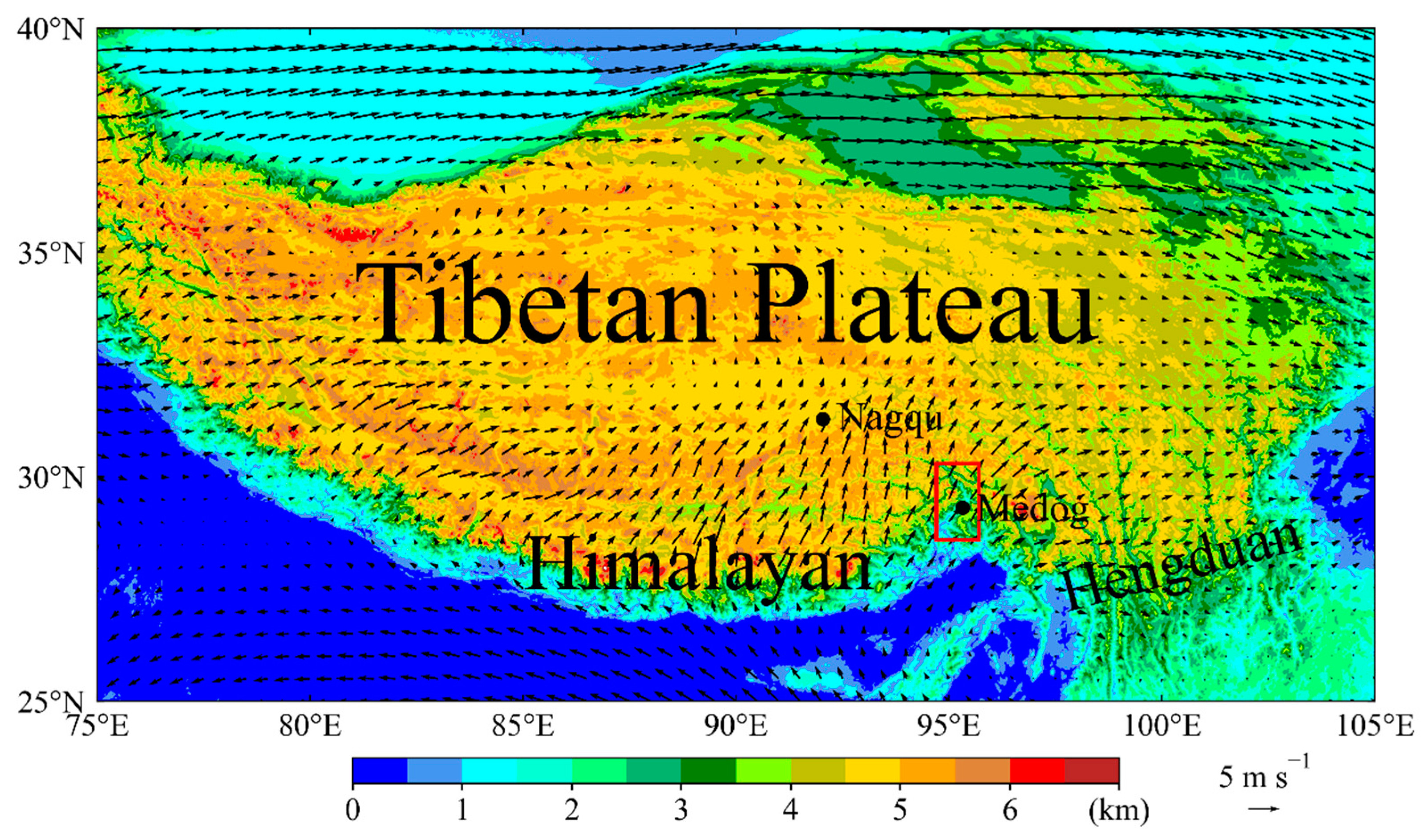


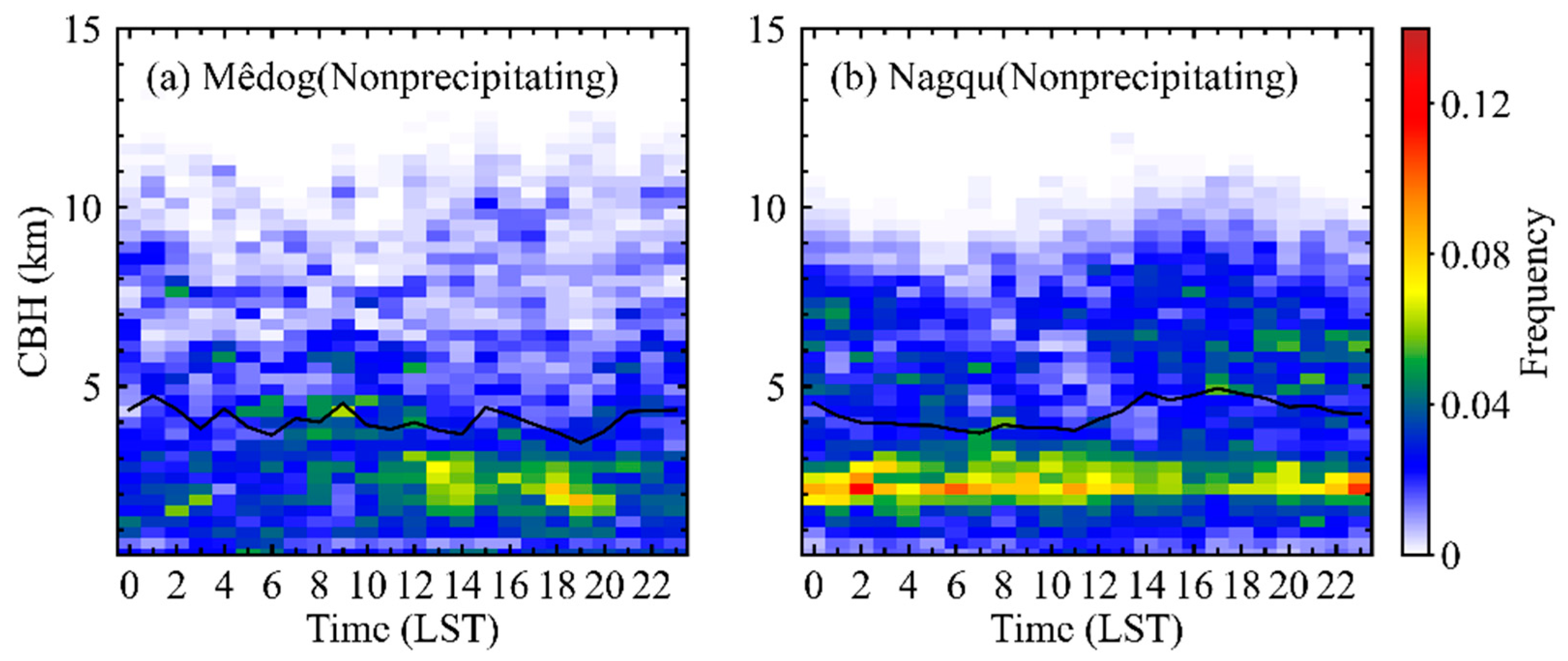

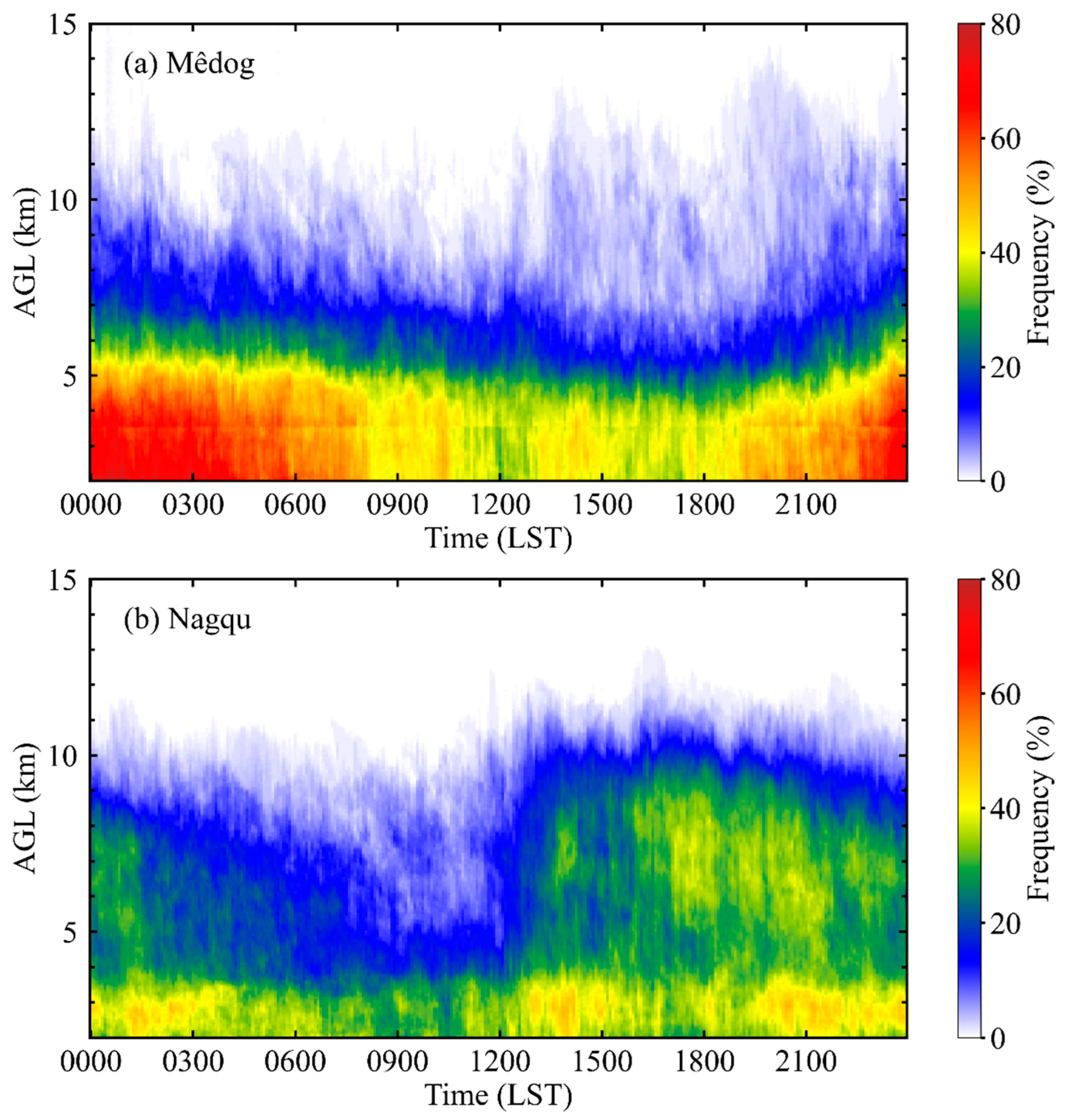
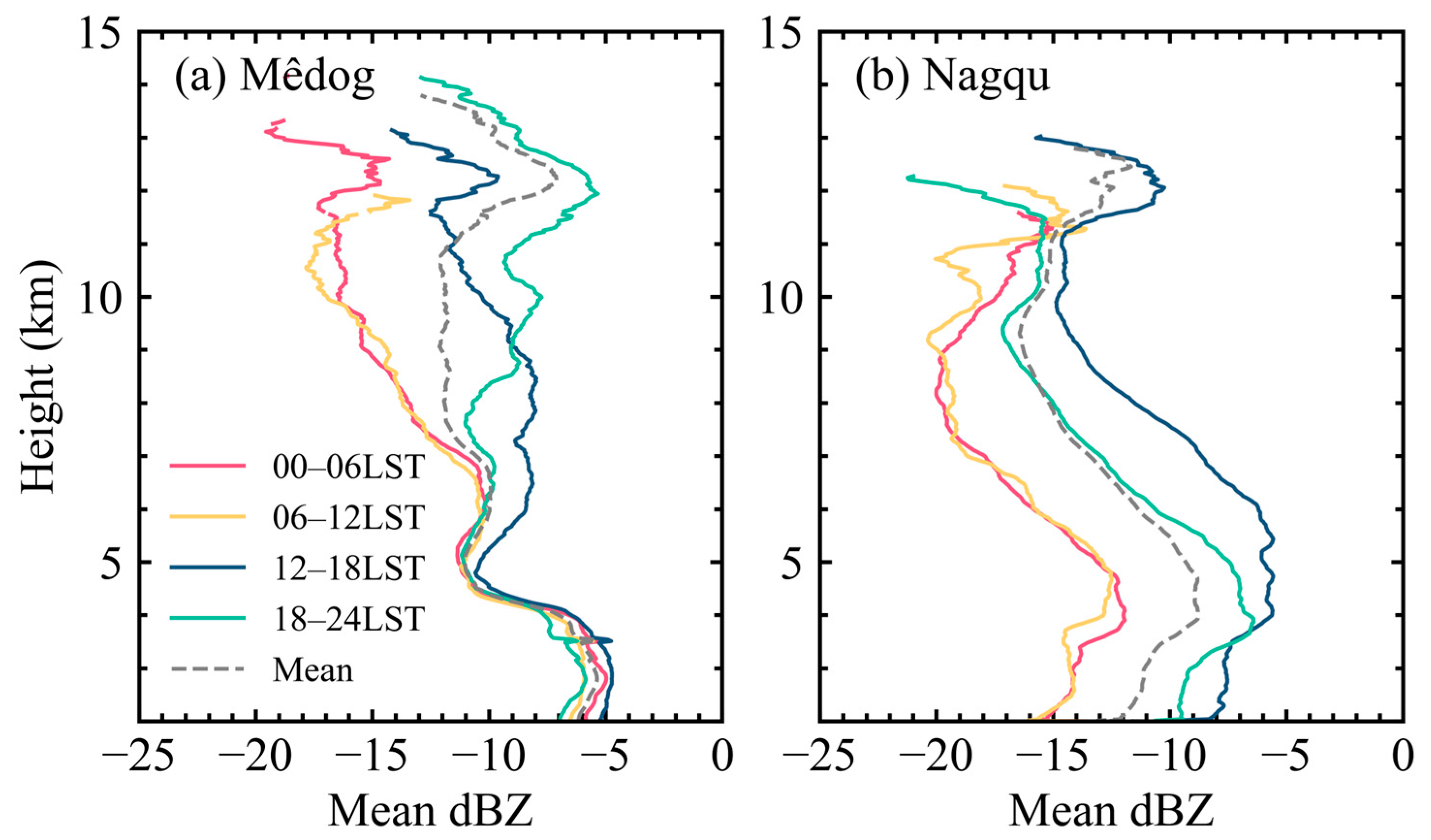

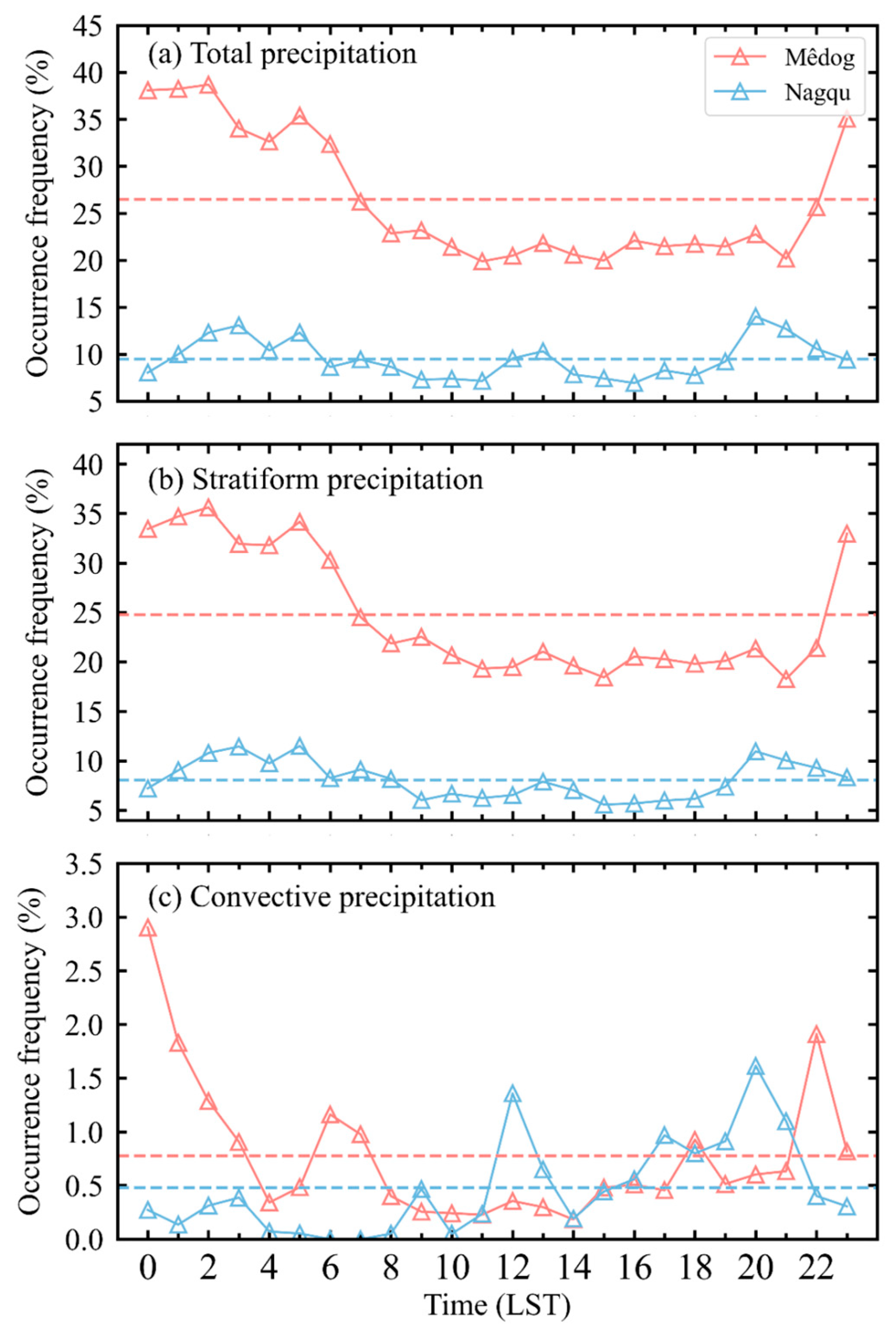
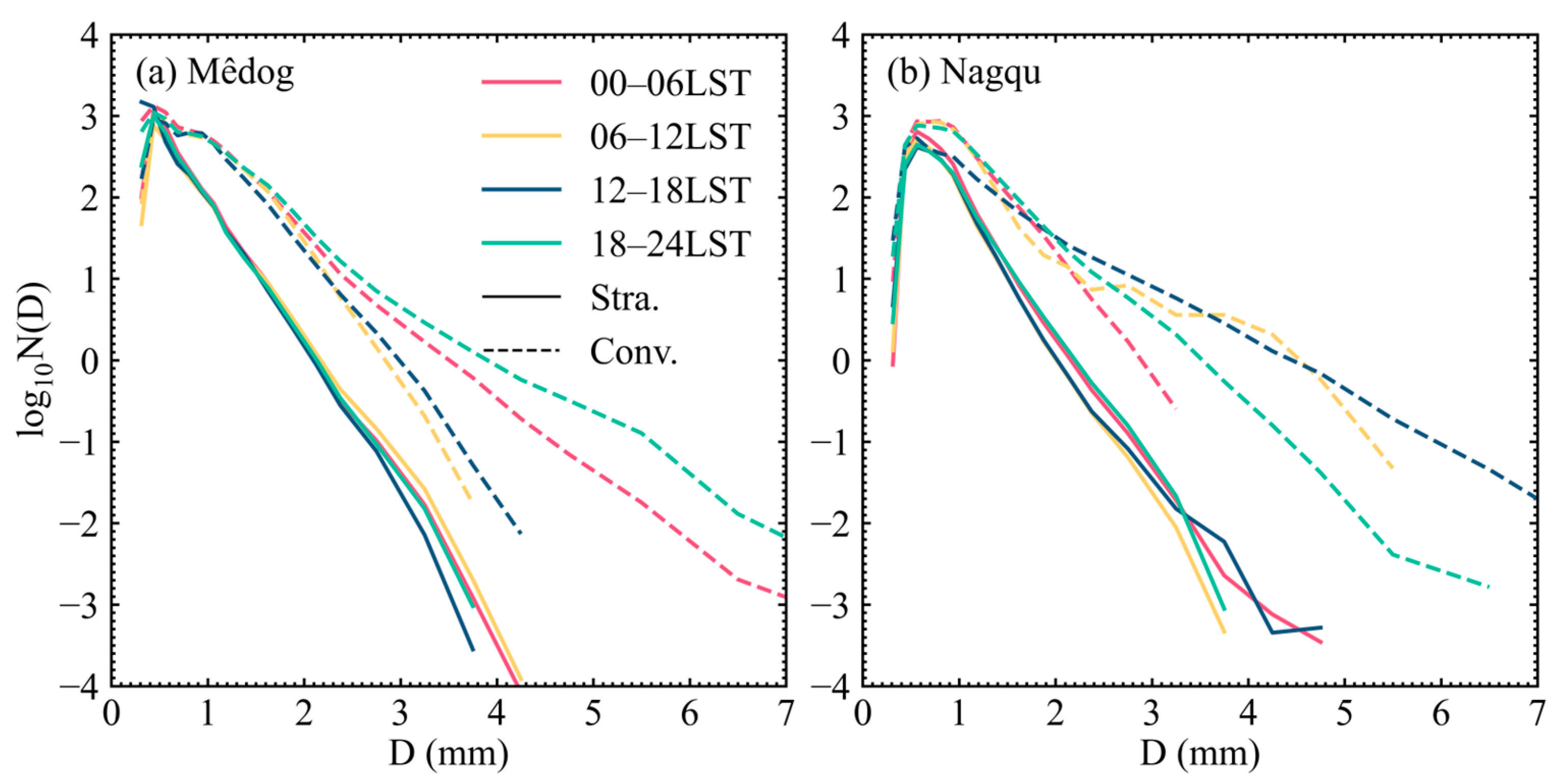
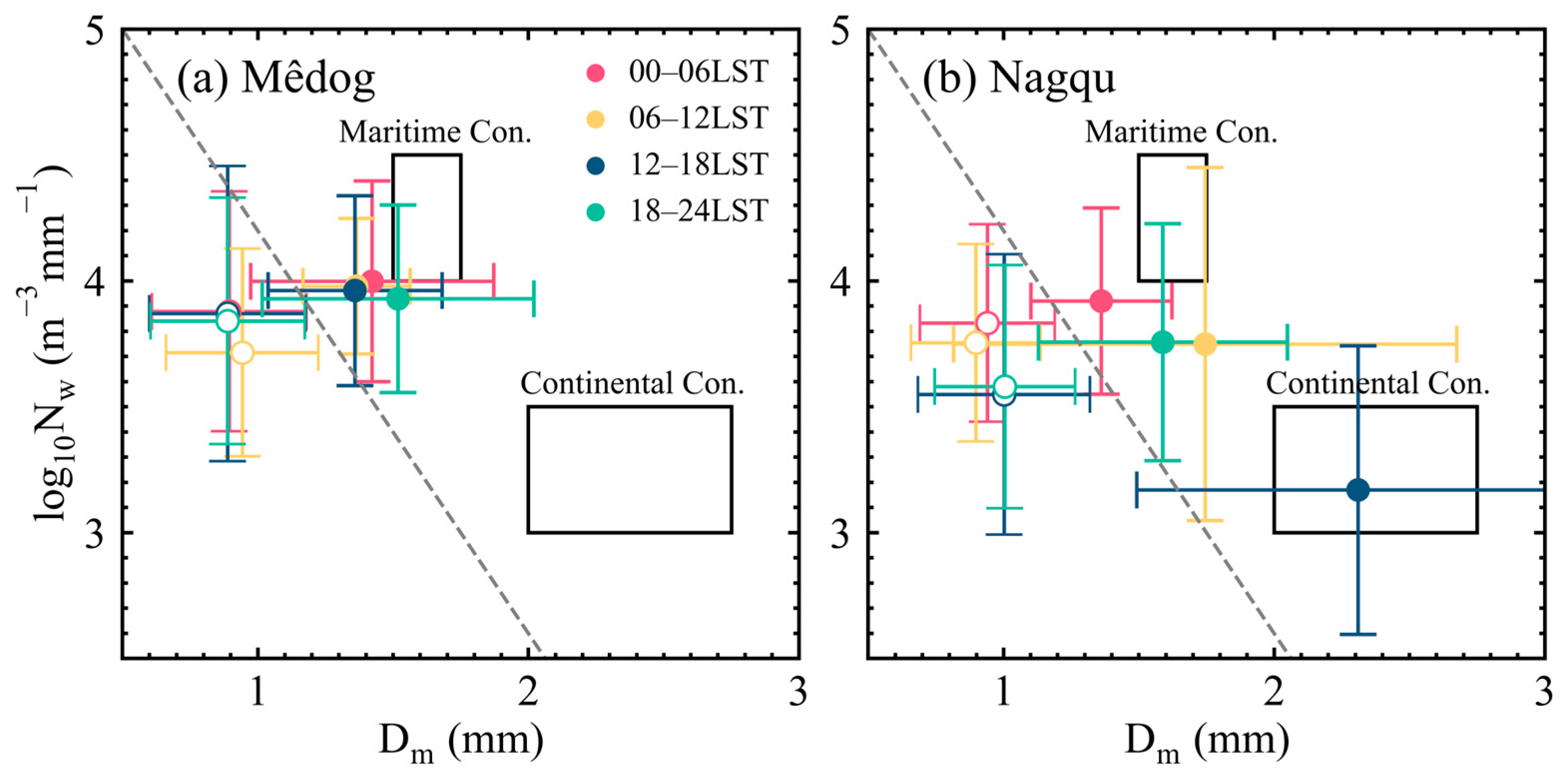
| Items | Technical Specifications |
|---|---|
| Working system | Pulsed wave Doppler, pulse compression |
| Transmitter type | All solid-state transmitter |
| Observation mode | Zenith-pointed vertically |
| Beam width | ≤0.35° |
| Working frequency | 33.44 GHz (Ka-band) |
| Measured variables | Reflectivity, radial velocity, velocity spectrum width, linear depolarization factor (LDR), power spectral density data |
| Maximum detection range | 15 km above ground level (AGL) |
| Mêdog | Nagqu | |
|---|---|---|
| All profiles | 439,170 | 828,367 |
| Total cloud cover profiles | 281,529 (64.1%) | 509,845 (61.5%) |
| Precipitation profiles | 146,040 (33.3%) | 93,974 (11.3%) |
| Single-layered cloud | 220,161 (50.1%) | 345,249 (41.7%) |
| Double-layered cloud | 51,477 (11.7%) | 124,993 (15.1%) |
| Triple-layered cloud | 8762 (2.0%) | 32,162 (3.9%) |
| Mêdog (Samples/Rain Rate (mm h−1)) | Nagqu (Samples/Rain Rate (mm h−1)) | |||
|---|---|---|---|---|
| Conv. | Stra. | Conv. | Stra. | |
| 00–06 | 544/11.08 | 14,183/1.26 | 71/7.3 | 3414/1.54 |
| 06–12 | 228/8.90 | 9736/1.12 | 47/8.88 | 2549/1.09 |
| 12–18 | 161/7.65 | 8416/1.01 | 246/14.0 | 2276/1.11 |
| 18–24 | 377/13.68 | 9342/1.12 | 313/10.31 | 3159/1.34 |
| Total | 1310/11.03 | 41,677/1.15 | 677/11.24 | 11,398/1.30 |
Disclaimer/Publisher’s Note: The statements, opinions and data contained in all publications are solely those of the individual author(s) and contributor(s) and not of MDPI and/or the editor(s). MDPI and/or the editor(s) disclaim responsibility for any injury to people or property resulting from any ideas, methods, instructions or products referred to in the content. |
© 2023 by the authors. Licensee MDPI, Basel, Switzerland. This article is an open access article distributed under the terms and conditions of the Creative Commons Attribution (CC BY) license (https://creativecommons.org/licenses/by/4.0/).
Share and Cite
Zhou, R.; Wang, G.; Zhao, K.; Liu, L.; Sun, J. Diurnal Variation Characteristics of Clouds and Precipitation during the Summer Season in Two Typical Climate Regions of the Tibetan Plateau. Remote Sens. 2023, 15, 3731. https://doi.org/10.3390/rs15153731
Zhou R, Wang G, Zhao K, Liu L, Sun J. Diurnal Variation Characteristics of Clouds and Precipitation during the Summer Season in Two Typical Climate Regions of the Tibetan Plateau. Remote Sensing. 2023; 15(15):3731. https://doi.org/10.3390/rs15153731
Chicago/Turabian StyleZhou, Renran, Gaili Wang, Kun Zhao, Liping Liu, and Jisong Sun. 2023. "Diurnal Variation Characteristics of Clouds and Precipitation during the Summer Season in Two Typical Climate Regions of the Tibetan Plateau" Remote Sensing 15, no. 15: 3731. https://doi.org/10.3390/rs15153731
APA StyleZhou, R., Wang, G., Zhao, K., Liu, L., & Sun, J. (2023). Diurnal Variation Characteristics of Clouds and Precipitation during the Summer Season in Two Typical Climate Regions of the Tibetan Plateau. Remote Sensing, 15(15), 3731. https://doi.org/10.3390/rs15153731








